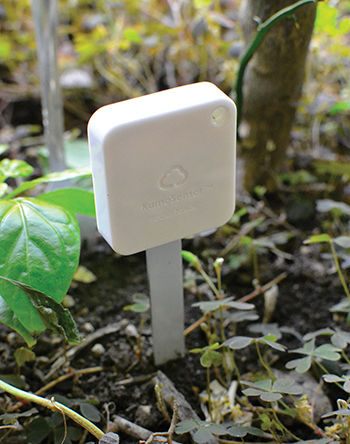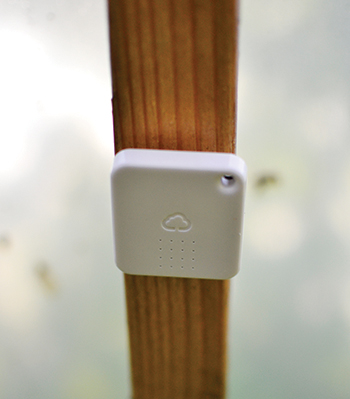Post your farm-made tool on Instagram or Facebook with #toolsforgrowingformarket. If author Josh Volk picks your tool, you win a $50 tool gift certificate and a Full Access subscription to GFM.
This article is in the August 2021 issue of Growing for Market Magazine
Earlier this year I wrote about Eric Stoffer’s automation in his tunnel at Bay Branch Farm. In talking to him he also mentioned that he uses Wireless Sensor Tags to monitor the temperature in his tunnel and that it shows him a graph of the temperature over time which makes him confident that his system has worked well. I got interested, did a little research, and decided to try a few of the Wireless Sensor Tag products to learn more about the temperatures in my new greenhouse that I just put up this year.
 The tag manager is pretty small with just a 4” long antenna.
The tag manager is pretty small with just a 4” long antenna.
To use the Wireless Sensor Tag you need to have a “Tag Manager,” which is a very small box with an antenna that connects by ethernet cable to your modem. You can then place up to 40 sensors within about 700’ and the sensors will send their data back to the manager. The manager then uploads the data to the internet where you can retrieve it.
 The moisture sensor in a potted plant.
The moisture sensor in a potted plant.
I realized after talking to him that I had first seen these sensors about eight years ago when I was working at Our Table Cooperative in Sherwood, Oregon. They were trying to use them to monitor walk in coolers and freezers, so I called up Narendra at Our Table and he warned me about some of the limitations they ran into. First, the radio signals don’t really like going through metal walls, so in a metal sided barn, filled with metal walled coolers, the signals weren’t great.
 The sensor stuck to a rafter in the greenhouse.
The sensor stuck to a rafter in the greenhouse.
Second, the sensors weren’t really built for super cold conditions and high condensation, so they had battery and corrosion problems. Still, Eric had been using them in his greenhouse and the price wasn’t too high, so I figured if they at least worked for a few months while I was learning how to best manage venting my new greenhouse, they’d be worth it. Conveniently, my greenhouse is also less than 50’ from my internet modem.
 This is the basic temperature, relative humidity, and ambient light sensor in my hand for scale.
This is the basic temperature, relative humidity, and ambient light sensor in my hand for scale.
The first two sensors I got were one of the simplest they offer, just giving temperature, and one that looks identical but also gives me relative humidity and ambient light readings. They come with Velcro stickers and I stuck the simple one to the exterior north wall of my garden shed, protected from rain under the overhang, and the fancier one I stuck to the underside of a rafter in my greenhouse, high enough to be out of the sprinkler range, but low enough to be close to the plants and out of direct sunlight.
 The outdoor temperature probe is fully sealed and I’m using it here to monitor the soil temperature of a flat on a heat mat.
The outdoor temperature probe is fully sealed and I’m using it here to monitor the soil temperature of a flat on a heat mat.
The initial set up is fairly straightforward, but some of the details to really get all of the features to work are less obvious. I can see the data from the sensors both on an app on my phone, and also on a website. By setting a normal range for temperature I can have the app alert me when the sensors go in and out of range and I’ve set it so I get a single text alert on my phone each time the greenhouse sensor goes in or out of the “normal” temperature range I’ve set.
This has turned out to be a nice reminder on several occasions to either open or close the greenhouse when I got distracted by other tasks. On the other hand, Eric told me the one time it would have been really helpful to him to get this reminder he happened to not have his phone on him so he missed the multiple alerts he had set, so it’s not completely fail safe.
The biggest reason I wanted to get the sensors was to see what the temperature, humidity and light were doing over the course of the day and to compare that to the outdoor temperature. It’s been super informative to be able to see clear graphs of how it all relates, and it accelerated my learning of when to vent the greenhouse and when to close it up in the evenings. I can also check on the conditions in the greenhouse anytime, anywhere from the app on my phone.
About a month after I got the first sensors the thermostat for my germination chamber died and a new one was backordered for three weeks, so I ordered a Wireless Sensor Tag indoor/outdoor temperature probe to pair with a Wemo smart outlet, as they were available to ship immediately. Like most of the Wireless Sensor Tags, the Wemo smart outlet is built for indoor use, but that was fine for my germination chamber which is in my basement.
 A screen shot of the graph of the greenhouse sensor data. You can see I have 60F as my low set point, so the temperature reading is a different color below 60F. It’s also obvious from the graph lines when sunrise and sunset are, and from the humidity line that the humidity goes way up when the greenhouse is shut up overnight and then drops during the day when I have it opened up. I’ve zoomed in to just look at a few days here, but you can easily zoom out to see the full history, or in closer to see the details of a single day.
A screen shot of the graph of the greenhouse sensor data. You can see I have 60F as my low set point, so the temperature reading is a different color below 60F. It’s also obvious from the graph lines when sunrise and sunset are, and from the humidity line that the humidity goes way up when the greenhouse is shut up overnight and then drops during the day when I have it opened up. I’ve zoomed in to just look at a few days here, but you can easily zoom out to see the full history, or in closer to see the details of a single day.
The data from the sensors can be used to drive the smart outlet so I searched around, found the right settings and after a few hours of fiddling I got the pair to work as a thermostat, turning the outlet on and off when the temperature got too low or high. By watching the graph of the data, I can monitor and see that it is working, and for about the same price as a dedicated thermostat.
 A screenshot of the website where I can see both my sensors and my smart outlets. In this shot, I’m looking at the snapshot of the sensor readings for the greenhouse conditions.
A screenshot of the website where I can see both my sensors and my smart outlets. In this shot, I’m looking at the snapshot of the sensor readings for the greenhouse conditions.
I’ve also used that same temperature probe, when I’m not using it for the germination chamber, to monitor the soil temperature in the trays on the bottom heat mats in my greenhouse, which has made me realize that while they do add heat, they’re not keeping up with the nighttime lows in my otherwise unheated space. I still get decent plants, but it shows me a way I might improve growth in the future.
I was curious about the moisture sensors Wireless Sensor Tags have so I bought one to try out. The whole thing isn’t waterproof, so I haven’t put it in the greenhouse to try it out, but I’ve been using it in houseplants. With a little experimentation I’ve figured out what the normal range readings are when the potting soil is saturated versus needing water so I may move it into the greenhouse soon and try it with a plastic bag covering the sensitive parts.
When I bought the Wemo smart outlet I got two, one for the germination chamber and a second to control a fan in the greenhouse (which is well within range of my wireless network). I’ve always wanted to be able to turn the fan off in coordination with my automatic water system so that the fan isn’t blowing while the sprinklers are on, but I’ve never had a good way to control that. The smart outlet allows me to set multiple times for the fan to run through the day and I can synchronize that with the times I have set on my automatic sprinklers so that the two don’t overlap. I’m unsure how long this will continue to work in the humid environment of the greenhouse, but they also sell more expensive indoor/outdoor versions so if this one fails, I may invest in one more suited to the environment.
My biggest questions about the long-term use of these sensors are how robust they’ll end up being, and the creeping environmental impact of more little disposable electronics. I’m sure there are other similar, and possibly more appropriate tools available out there, but this isn’t usually the kind of thing I’m looking for, so I haven’t done a lot of research. If you have a solution for these problems that you love, or really any tool you love, high-tech or not, please share it with all of us by using the tag #toolsforgrowingformarket on Instagram or Facebook, or by contacting me directly.
Josh Volk farms in Portland, Oregon, and does consulting and education under the name Slow Hand Farm. He is the author of the book Build Your Own Farm Tools and Compact Farms: 15 Proven Plans for Market Farms on 5 Acres or Less, available from Growing for Market. He can be found at SlowHandFarm.com.

